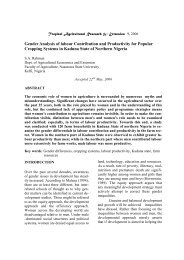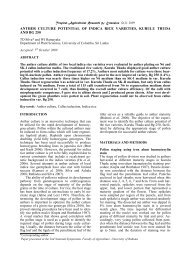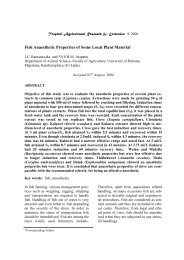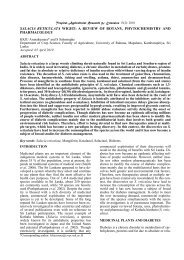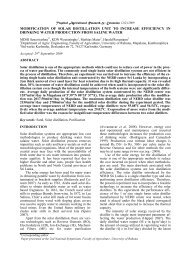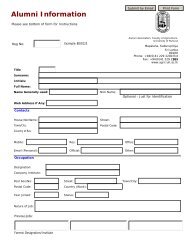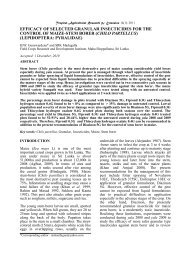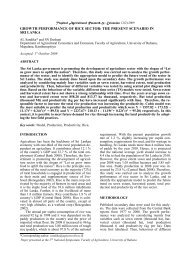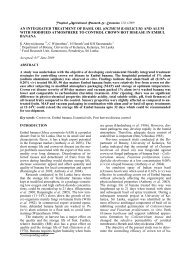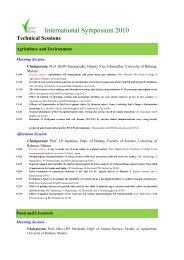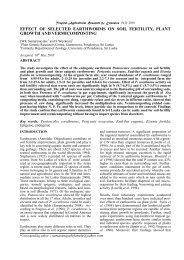growth performance of rice sector: the present scenario in sri lanka
growth performance of rice sector: the present scenario in sri lanka
growth performance of rice sector: the present scenario in sri lanka
You also want an ePaper? Increase the reach of your titles
YUMPU automatically turns print PDFs into web optimized ePapers that Google loves.
Tropical Agricultural Research & Extension 12(2):2009<br />
GROWTH PERFORMANCE OF RICE SECTOR: THE PRESENT SCENARIO IN<br />
SRI LANKA<br />
AL Sandika* and SN Dushani<br />
Department <strong>of</strong> Agricultural Economics and Extension, Faculty <strong>of</strong> Agriculture, University <strong>of</strong> Ruhuna,<br />
Mapalana, Kamburupitiya<br />
Accepted: 1 st October 2009<br />
ABSTRACT<br />
The Sri Lanka government is promot<strong>in</strong>g <strong>the</strong> development <strong>of</strong> agriculture <strong>sector</strong> with <strong>the</strong> slogan <strong>of</strong> “Let<br />
us grow more to uplift <strong>the</strong> nation”. Therefore, this study was carried out to analyse <strong>the</strong> <strong>growth</strong> <strong>performance</strong><br />
<strong>of</strong> <strong>rice</strong> <strong>sector</strong>, and to identify <strong>the</strong> appropriate model to predict <strong>the</strong> future trend <strong>of</strong> <strong>the</strong> <strong>sector</strong><br />
<strong>in</strong> Sri Lanka. The study was ma<strong>in</strong>ly done based upon <strong>the</strong> secondary data. The <strong>growth</strong> <strong>performance</strong> was<br />
analyzed by consider<strong>in</strong>g ma<strong>in</strong>ly four variables such as sown extent, harvested extent, total production<br />
and productivity. Then, behaviour <strong>of</strong> different variables was tested by us<strong>in</strong>g scatted plot diagram with<br />
time. Based on <strong>the</strong> behaviour <strong>of</strong> <strong>the</strong> variable, different time series (TS) models were tested. Sown extent<br />
and harvested extent have not shown a strong relationship with time. Average sown extent and harvested<br />
extent were recorded 858.28 and 813.37 ha thousand, respectively. But total production<br />
(thousand Mt) and productivity (kg per ha) have <strong>in</strong>creased significantly with time. Therefore, <strong>the</strong> responsible<br />
factor to <strong>in</strong>crease <strong>the</strong> total <strong>rice</strong> production was <strong>in</strong>crement <strong>of</strong> <strong>the</strong> productivity. Cubic model<br />
was <strong>the</strong> most suitable to predict <strong>the</strong> total production and productivity which were Y = 1557.82 + 173.52t<br />
- 11.17t 2 + 0.24t 3 (r 2 = 89.51) and Y = 2227.67+ 210.13 t - 11.19t 2 + 0.22t 3 (r 2 = 95.20) respectively. In this<br />
context, it is possible to meet future demand for <strong>rice</strong> through <strong>in</strong>creas<strong>in</strong>g <strong>the</strong> land productivity by adopt<strong>in</strong>g<br />
<strong>the</strong> best field practices.<br />
Key words: Model, Production and productivity, Rice<br />
INTRODUCTION<br />
Agriculture has been <strong>the</strong> backbone <strong>of</strong> Sri Lankan<br />
economy with one-third <strong>of</strong> <strong>the</strong> rural population dependent<br />
on agriculture. It contributes about 12.1 %<br />
<strong>of</strong> <strong>the</strong> country’s GDP and 32.7 % <strong>of</strong> <strong>the</strong> total employment<br />
(Central Bank 2008). Therefore, <strong>the</strong> Government<br />
is promot<strong>in</strong>g <strong>the</strong> development <strong>of</strong> agriculture<br />
<strong>sector</strong> with <strong>the</strong> slogan <strong>of</strong> “Let us grow more<br />
food to uplift <strong>the</strong> nation”. Rice is <strong>the</strong> pr<strong>in</strong>ciple contributor<br />
<strong>of</strong> <strong>the</strong> rural economy as <strong>the</strong> majority (72%)<br />
<strong>of</strong> rural households is engaged <strong>in</strong> production <strong>of</strong> <strong>rice</strong><br />
as <strong>the</strong>ir ma<strong>in</strong> and supplementary source <strong>of</strong> livehood<br />
(Henegedara 2002). Rice is <strong>the</strong> ma<strong>in</strong> crop cultivated<br />
by <strong>the</strong> majority <strong>of</strong> farmers <strong>in</strong> rural areas and<br />
it is <strong>the</strong> staple food <strong>of</strong> <strong>the</strong> 18.6 million <strong>in</strong>habitants<br />
<strong>of</strong> Sri Lanka. Fur<strong>the</strong>r, it is <strong>the</strong> livelihood <strong>of</strong> more<br />
than 1.8 million farmers. Rice contributes 1.8 % <strong>of</strong><br />
country’s GDP, (Central Bank 2008). Rice is cultivated<br />
<strong>in</strong> almost all parts <strong>of</strong> <strong>the</strong> country, except at<br />
very high altitudes, as a wetland crop (Henegedara<br />
2002).<br />
The annual per capita consumption <strong>of</strong> <strong>rice</strong> was<br />
around 92 kg <strong>in</strong> 1998 and it was dependent on <strong>the</strong><br />
paddy production <strong>in</strong> <strong>the</strong> country and <strong>the</strong> p<strong>rice</strong> <strong>of</strong><br />
imported wheat flour. In 2008 it was <strong>in</strong>creased up<br />
to 96 kg and total production was 3,875 thousand<br />
metric tons <strong>of</strong> rough <strong>rice</strong> (paddy), which is about<br />
97.8 % <strong>of</strong> <strong>the</strong> national requirement. With <strong>the</strong> <strong>present</strong><br />
population <strong>growth</strong> rate <strong>of</strong> 1.2 %, slightly <strong>in</strong>creas<strong>in</strong>g<br />
per capita consumption, requirements for<br />
seed, and for wastage <strong>in</strong> handl<strong>in</strong>g, Sri Lanka needs<br />
more than 4,000 thousand metric tons <strong>of</strong> paddy by<br />
<strong>the</strong> year 2010. Hence, it is projected that <strong>the</strong> national<br />
average yield should <strong>in</strong>crease to 4.4 t/ha to<br />
feed <strong>the</strong> population <strong>of</strong> Sri Lanka <strong>in</strong> 2010. However,<br />
<strong>the</strong> gross extent sown and production <strong>in</strong> year 2008<br />
were 1053 thousand hectares and 3,875 thousand<br />
metric tons. Paddy production <strong>in</strong> 2008 year was<br />
<strong>in</strong>creased by 23.8 %, (Central Bank 2008). Therefore,<br />
this study was carried out to analyze <strong>the</strong><br />
<strong>growth</strong> <strong>performance</strong> <strong>of</strong> <strong>rice</strong> <strong>sector</strong> <strong>in</strong> Sri Lanka, and<br />
to identify <strong>the</strong> appropriate model to predict <strong>the</strong> future<br />
trend on sown extent (thousand ha), harvested<br />
extent (thousand ha), total production (thousand<br />
Mt) and productivity (kg per ha) <strong>of</strong> <strong>the</strong> <strong>rice</strong> <strong>sector</strong>.<br />
METHODOLOGY<br />
Published secondary data were used for this analysis.<br />
The data were collected from <strong>the</strong> Central Bank<br />
reports from 1977 to 2008. The <strong>growth</strong> <strong>performance</strong><br />
was analyzed by consider<strong>in</strong>g ma<strong>in</strong>ly four variables<br />
such as sown extent (thousand ha), harvested<br />
extent (thousand ha), total production (thousand<br />
Mt) and productivity (kg per ha). Data were first<br />
tabulated. Then, behaviour <strong>of</strong> different variables<br />
*Correspond<strong>in</strong>g author<br />
Paper <strong>present</strong>ed at <strong>the</strong> 2nd National Symposium, Faculty <strong>of</strong> Agriculture, University <strong>of</strong> Ruhuna
Production (000Mt) / Productivity (Kg/ha)<br />
Sown / Harvested extent (ha 000)<br />
78<br />
AL SANDIKA AND SN DUSHANI : GROWTH PERFORMANCE OF RICE SECTOR IN SRI LANKA<br />
was tested by us<strong>in</strong>g scatted plot diagram aga<strong>in</strong>st<br />
time factor (Runyon at el. 1996). Based on <strong>the</strong> behaviour<br />
<strong>of</strong> <strong>the</strong> variable, different time series (TS)<br />
models viz; l<strong>in</strong>ear model, polynomial such as Quadratic<br />
and Cubic models with <strong>the</strong> time factor were<br />
tested (Madridakis et al. 1983). The different models<br />
have been shown by <strong>the</strong> follow<strong>in</strong>g formulas.<br />
L<strong>in</strong>ear model (Y = a + bX),<br />
Quadratic model (Y = a + b 1 X + b X 2 )<br />
Qubic model (Y= a +b 1 X +b 2 X 2 +b 3 X 3 )<br />
Whereas, Y = production, X = time period,<br />
a = <strong>in</strong>tercept and b, b 1 , b 2 , b 3 = regression coefficients<br />
Coefficient <strong>of</strong> determ<strong>in</strong>ation expla<strong>in</strong>s <strong>the</strong> ratio <strong>of</strong><br />
<strong>the</strong> expla<strong>in</strong>ed variation to <strong>the</strong> total variation. It is<br />
alternatively called as <strong>the</strong> goodness <strong>of</strong> fit <strong>of</strong> model.<br />
Therefore <strong>the</strong> goodness <strong>of</strong> fit <strong>of</strong> models was tested<br />
by us<strong>in</strong>g coefficients <strong>of</strong> determ<strong>in</strong>ation (R 2 )<br />
(Majumdar 2002). Coefficient <strong>of</strong> determ<strong>in</strong>ation was<br />
measured by apply<strong>in</strong>g formula (i).<br />
R 2 = å (y’- ÿ) 2 / å(y-ÿ) 2 ……………(i)<br />
Whereas, Y = production, y’ = predicted production<br />
and ÿ= mean production<br />
Based on <strong>the</strong> selected best TS model, appropriate<br />
forecast<strong>in</strong>g model for different variables <strong>of</strong> <strong>rice</strong><br />
were developed.<br />
RESULTS AND DISCUSSION<br />
cultivated <strong>in</strong> two dist<strong>in</strong>ct cultivation seasons. The<br />
major cultivation season (Maha) which is from late<br />
September to early March is fed with <strong>in</strong>termonsoon<br />
ra<strong>in</strong>s and with <strong>the</strong> Nor<strong>the</strong>ast monsoon,<br />
which is well distributed <strong>in</strong> <strong>the</strong> Island. The m<strong>in</strong>or<br />
cultivation season (Yala), which is from early April<br />
to early September, br<strong>in</strong>gs ra<strong>in</strong> mostly to <strong>the</strong> Southwest<br />
region <strong>of</strong> Sri Lanka. Therefore, <strong>the</strong> extent under<br />
paddy cultivation <strong>in</strong> Yala is lower than that <strong>of</strong><br />
Maha season. Water availability is <strong>the</strong> major factor<br />
that determ<strong>in</strong>es <strong>the</strong> cultivation land extent <strong>in</strong> <strong>the</strong><br />
country.<br />
In year 2008, <strong>the</strong> gross extent sown and production<br />
were 1,053 thousand ha and 3,875 thousand<br />
metric tons respectively (Central Bank 2009). However,<br />
sown extent and harvested extent have not<br />
<strong>in</strong>creased significantly with <strong>the</strong> time. It has shown<br />
high variation year by year. Fur<strong>the</strong>r, average sown<br />
extent and harvested extent were recorded 858.28<br />
and 813.37 thousand ha, respectively. Year like<br />
1984, 1995 and 2007/08 cultivated extent have<br />
reached to <strong>the</strong> maximum number, (Central Bank<br />
1985; 1996 and 2009). Fig. 1 illustrates that <strong>the</strong><br />
highest number <strong>of</strong> land extent have been cultivated<br />
<strong>in</strong> 2008. It means that Sri Lanka has maximally<br />
used <strong>the</strong> suitable land for <strong>rice</strong> cultivation. If water<br />
is available at <strong>the</strong> correct time <strong>in</strong> <strong>the</strong> season, all <strong>rice</strong><br />
farmers cultivate <strong>the</strong>ir land. In addition, market<br />
p<strong>rice</strong> <strong>of</strong> paddy, government <strong>in</strong>centive and subsidies<br />
also affect to <strong>the</strong> cultivation.<br />
However, Fig. 2 clearly illustrates total production<br />
(thousand Mt) and productivity (kg per ha)<br />
have a strong relationship with time. Though <strong>the</strong><br />
1200<br />
1000<br />
Sown<br />
Harvested<br />
Performance <strong>of</strong> cultivate extent, harvested extent,<br />
<strong>rice</strong> production and productivity<br />
In Sri Lanka, <strong>rice</strong> is grown under a wide range <strong>of</strong><br />
physical environments such as different elevations,<br />
soils and hydrological regimes. There is a wide<br />
range <strong>of</strong> climatic and soil conditions <strong>in</strong> <strong>the</strong> country.<br />
Based on <strong>the</strong> ra<strong>in</strong>fall and elevation, seven major<br />
agro-ecological zones (AEZ) have been identified<br />
(LCDZ, LCIZ, LCWZ, MCIZ, MCWZ, UCIZ and<br />
UCWZ). These AEZ were fur<strong>the</strong>r subdivided <strong>in</strong>to<br />
24 agro-ecological regions, consider<strong>in</strong>g <strong>the</strong> ra<strong>in</strong>fall<br />
distribution, soil type and <strong>the</strong> landform. Rice is<br />
grown <strong>in</strong> all <strong>the</strong> agro-ecological regions except <strong>in</strong><br />
WU 1 , WU 2 , WU 3 and IU 2 . If water conditions are<br />
right, almost all k<strong>in</strong>ds <strong>of</strong> soils could be used for <strong>rice</strong><br />
cultivation. In Sri Lanka, <strong>the</strong> hydromorphic associates<br />
<strong>of</strong> almost all its great soil groups are used for<br />
<strong>rice</strong> cultivation, (Panabokke 1996). Therefore, compared<br />
to many o<strong>the</strong>r <strong>rice</strong> grow<strong>in</strong>g countries, Sri<br />
Lanka grows <strong>rice</strong> under a wide range <strong>of</strong> environmental<br />
conditions. Fur<strong>the</strong>r, <strong>rice</strong> lands <strong>in</strong> Sri Lanka<br />
are fur<strong>the</strong>r categorized ei<strong>the</strong>r as irrigated (major<br />
and m<strong>in</strong>or irrigation systems) or as ra<strong>in</strong>-fed and are<br />
800<br />
600<br />
400<br />
200<br />
0<br />
1977<br />
1979<br />
1981<br />
1983<br />
1985<br />
1987<br />
1989<br />
1991<br />
1993<br />
1995<br />
1997<br />
1999<br />
2001<br />
2003<br />
2005<br />
2007<br />
Figure 1: Sown extent and harvested extent <strong>of</strong> <strong>rice</strong><br />
from 1977 to 2008<br />
5000<br />
4500<br />
4000<br />
3500<br />
3000<br />
2500<br />
2000<br />
1500<br />
1000<br />
500<br />
0<br />
1977<br />
1979<br />
Production<br />
Productivity<br />
1981<br />
1983<br />
1985<br />
1987<br />
1989<br />
1991<br />
1993<br />
1995<br />
1997<br />
1999<br />
2001<br />
2003<br />
2005<br />
2007<br />
Figure 2: Total production and productivity <strong>of</strong> <strong>rice</strong><br />
from 1977 to 2008
sown extent and harvested extent were not <strong>in</strong>creased<br />
significantly from 1977 to 2008 but <strong>the</strong><br />
total production and productivity have <strong>in</strong>creased<br />
significantly <strong>in</strong> considered time period. Total production<br />
and productivity have <strong>in</strong>creased by 235.7,<br />
and 178.9 % respectively. Therefore, <strong>the</strong> responsible<br />
factor to <strong>in</strong>crease <strong>the</strong> total <strong>rice</strong> production was<br />
<strong>in</strong>crement <strong>of</strong> <strong>the</strong> productivity. The country <strong>rice</strong> productivity<br />
is now above <strong>the</strong> 4,000 kg/ha.<br />
On this background, future demand <strong>of</strong> <strong>rice</strong><br />
should be met through <strong>in</strong>creas<strong>in</strong>g <strong>the</strong> productivity<br />
<strong>of</strong> <strong>the</strong> land. The total production and productivity<br />
can be fur<strong>the</strong>r <strong>in</strong>creased through better field practices<br />
because potential yield <strong>of</strong> different <strong>rice</strong> varieties<br />
are still higher than <strong>the</strong> actual yield (Table 1).<br />
The coefficient <strong>of</strong> determ<strong>in</strong>ation values (R 2 ) for<br />
<strong>the</strong> different forecast<strong>in</strong>g model <strong>in</strong> terms <strong>of</strong> cultivated<br />
land extent and harvested land extent <strong>of</strong> <strong>rice</strong><br />
have shown non significant results. Therefore, <strong>the</strong>re<br />
was no any appropriate model to predict <strong>the</strong> future<br />
trend <strong>in</strong> terms <strong>of</strong> cultivated land extent <strong>of</strong> <strong>rice</strong>. The<br />
values <strong>of</strong> coefficient <strong>of</strong> determ<strong>in</strong>ation <strong>of</strong> <strong>the</strong> different<br />
forecast<strong>in</strong>g model have shown by <strong>the</strong> table 2.<br />
The highest R 2 value has recorded to <strong>the</strong> cubic<br />
model. For that reason, most suitable predict<strong>in</strong>g<br />
model for <strong>the</strong> total production and productivity <strong>of</strong><br />
<strong>rice</strong> was cubic model. Cubic model is <strong>the</strong> most appropriate<br />
model for forecast<strong>in</strong>g <strong>the</strong> future <strong>rice</strong> production<br />
and productivity. The developed model for<br />
total production was Y = 1557.82 + 173.52t -<br />
11.17t 2 + 0.24t 3 (r 2 = 89.51) while developed model<br />
for productivity was Y = 2227.67+ 210.13 t -<br />
11.19t 2 + 0.22t 3 (r 2 = 95.20).<br />
Potential strategies for narrow<strong>in</strong>g <strong>the</strong> yield<br />
gap<br />
A comprehensive programme from land preparation<br />
to consumption <strong>of</strong> <strong>rice</strong> is required to <strong>in</strong>crease<br />
<strong>the</strong> productivity by reduc<strong>in</strong>g <strong>the</strong> yield gap. Attention<br />
should be made to <strong>the</strong> <strong>in</strong>crease production and<br />
Table 1: Potential yield <strong>of</strong> different <strong>rice</strong> varieties<br />
Variety Duration<br />
(Months)<br />
Potential yield (t/<br />
ha)<br />
BG 300 3.0 6.5<br />
BG 94-1 3.5 7.0<br />
BG 352 3.5 7.0<br />
BG 350 3.5 7.0<br />
BG 379-2 4.0 7.5<br />
BG 403 4.0 7.5<br />
BG 400-1 4.0 7.5<br />
BG 304 3.0 6.0<br />
BW 351 3.5 7.0<br />
BG 450 4.5 7.0<br />
LD 355 3.5 5.0<br />
BG- Batalagoda, AT- Ambalantota, BW- Bombuwela, LD-<br />
Labuduwa<br />
** - Yield potential at respective breed<strong>in</strong>g stations (Source:<br />
Dhanapala 2000)<br />
Tropical Agricultural Research & Extension 12(2):2009<br />
productivity ra<strong>the</strong>r than <strong>in</strong>creas<strong>in</strong>g <strong>the</strong> cultivate<br />
land extent.<br />
I. Increas<strong>in</strong>g paddy production<br />
Production extent <strong>in</strong> <strong>the</strong> country cannot be <strong>in</strong>creased<br />
any fur<strong>the</strong>r, but <strong>the</strong> cropp<strong>in</strong>g <strong>in</strong>tensity<br />
could be <strong>in</strong>creased any way. Dhanapala, (2000)<br />
revealed that <strong>the</strong> cropp<strong>in</strong>g <strong>in</strong>tensity can be easily<br />
<strong>in</strong>creased from 119 % to about 130 %, so that <strong>the</strong><br />
total annual cultivated extent would be 0.96 million<br />
ha. More <strong>of</strong> <strong>the</strong> neglected ra<strong>in</strong>-fed <strong>rice</strong> lands <strong>in</strong> <strong>the</strong><br />
Low Country Wet Zone as well as those with supplementary<br />
irrigation facilities (m<strong>in</strong>or irrigation<br />
systems) <strong>in</strong> <strong>the</strong> Dry and Intermediate Zones have to<br />
be given due priority <strong>in</strong> <strong>the</strong> rehabilitation process to<br />
improve cropp<strong>in</strong>g <strong>in</strong>tensity as envisaged.<br />
II. Bridg<strong>in</strong>g <strong>the</strong> yield gap<br />
Comprehensive programmes are needed to improve<br />
<strong>the</strong> productivity. A technical component, address<strong>in</strong>g<br />
issues perta<strong>in</strong><strong>in</strong>g to genotype and environment<br />
<strong>in</strong>teraction are discussed below.<br />
III. Appropriate cultivars<br />
Emphasis is given to location specific cultivars to<br />
maximize <strong>the</strong> use <strong>of</strong> natural resources. Gra<strong>in</strong> yield<br />
<strong>of</strong> <strong>rice</strong> could be <strong>in</strong>creased by grow<strong>in</strong>g medium duration<br />
(4 month) cultivars ra<strong>the</strong>r than short duration<br />
cultivars. It is <strong>in</strong>tended to <strong>in</strong>crease <strong>the</strong> <strong>present</strong> extent<br />
under medium duration cultivars (4 month)<br />
wherever possible. However, when water is limit<strong>in</strong>g,<br />
<strong>in</strong>creas<strong>in</strong>g <strong>the</strong> cultivated extent us<strong>in</strong>g short duration<br />
cultivars (3-3.5 month) with <strong>in</strong>tensive management<br />
is recommended.<br />
IV. Use <strong>of</strong> quality seed <strong>rice</strong><br />
Use <strong>of</strong> quality seed <strong>rice</strong> to maximize yield and to<br />
ma<strong>in</strong>ta<strong>in</strong> quality <strong>of</strong> <strong>the</strong> harvest is encouraged. However,<br />
supply <strong>of</strong> seed <strong>rice</strong> to farmers at an affordable<br />
p<strong>rice</strong> at <strong>the</strong> correct time is <strong>in</strong>creas<strong>in</strong>gly difficult.<br />
Therefore self-seed <strong>rice</strong> production is encouraged<br />
while <strong>the</strong> farmer is supplied with m<strong>in</strong>i-kits <strong>of</strong> seed<br />
with new cultivars for multiplication. Private <strong>sector</strong><br />
participation <strong>in</strong> <strong>the</strong> seed <strong>in</strong>dustry is also encouraged<br />
by <strong>the</strong> government.<br />
V. Collective and timely (seasonal) cultivation<br />
Timely cultivation with <strong>the</strong> onset <strong>of</strong> monsoon ra<strong>in</strong>s<br />
is essential to economize <strong>the</strong> use <strong>of</strong> <strong>in</strong>puts and to<br />
maximize <strong>the</strong> use <strong>of</strong> natural resources. Delayed<br />
plant<strong>in</strong>g especially <strong>in</strong> <strong>the</strong> Maha (October-March)<br />
Table 2: Coefficient <strong>of</strong> determ<strong>in</strong>ation values (R2) <strong>of</strong><br />
different forecast<strong>in</strong>g models for production and productivity<br />
<strong>of</strong> <strong>rice</strong>(%)<br />
Criteria L<strong>in</strong>ear regression<br />
Quadratic Cubic<br />
model model model<br />
Production 67.5 69.7 80.1<br />
Productivity 81.0 81.7 90.7<br />
79
80<br />
AL SANDIKA AND SN DUSHANI : GROWTH PERFORMANCE OF RICE SECTOR IN SRI LANKA<br />
season affects <strong>the</strong> <strong>growth</strong> and <strong>the</strong> age <strong>of</strong> <strong>the</strong> <strong>rice</strong><br />
crop. Farmers are encouraged to follow a uniform<br />
cultivation calendar without any overlapp<strong>in</strong>g <strong>of</strong><br />
different <strong>growth</strong> stages <strong>in</strong> a given tract. This would<br />
help to <strong>in</strong>tegrate crop management practices on a<br />
tract basis thus reduc<strong>in</strong>g time spent on ma<strong>in</strong>ta<strong>in</strong><strong>in</strong>g<br />
<strong>in</strong>dividual crops. Fur<strong>the</strong>r, it would make <strong>the</strong> job <strong>of</strong><br />
extension and related support<strong>in</strong>g services easy as<br />
well as organiz<strong>in</strong>g market<strong>in</strong>g and o<strong>the</strong>r activities<br />
properly.<br />
IX. Weed management<br />
Weed management is a major problem <strong>in</strong> <strong>rice</strong> as<br />
water is limit<strong>in</strong>g <strong>in</strong> most <strong>in</strong>stances. It is recommended<br />
to practice <strong>in</strong>tegrated weed management by<br />
proper land preparation and by us<strong>in</strong>g manual, mechanical<br />
and chemical weed management practices.<br />
Use <strong>of</strong> correct herbicides at <strong>the</strong> appropriate stage <strong>of</strong><br />
crop <strong>growth</strong> and application <strong>of</strong> <strong>the</strong> correct dosage<br />
are important to improve <strong>the</strong> effectiveness <strong>of</strong> <strong>the</strong><br />
weed control by <strong>the</strong> chemical method.<br />
VI. Match<strong>in</strong>g <strong>the</strong> season with <strong>the</strong> climatic<br />
change<br />
Match<strong>in</strong>g <strong>the</strong> season accordantly to <strong>the</strong> climatic<br />
changes is required. Many farmers have compla<strong>in</strong>ed<br />
that <strong>the</strong> monsoons are not com<strong>in</strong>g <strong>the</strong> time<br />
due to changes <strong>of</strong> climate. Sandika and Withana<br />
(2009) found that majority <strong>of</strong> farmers’ perception<br />
on <strong>the</strong> north-east monsoon is more altered than<br />
south-west monsoon. Accord<strong>in</strong>g to <strong>the</strong>ir f<strong>in</strong>d<strong>in</strong>gs<br />
<strong>the</strong> season need to be adjusted accord<strong>in</strong>gly.<br />
VII. Soil fertility improvement and sustenance<br />
Improvement <strong>of</strong> <strong>the</strong> soil’s physical, chemical and<br />
biological status for its susta<strong>in</strong>ability is <strong>the</strong> key feature<br />
<strong>of</strong> this whole package <strong>of</strong> practices. At <strong>present</strong>,<br />
due to <strong>the</strong> <strong>in</strong>creased cropp<strong>in</strong>g <strong>in</strong>tensity and high<br />
temperature, <strong>the</strong> organic matter content <strong>in</strong> <strong>rice</strong><br />
fields <strong>in</strong> <strong>the</strong> Dry and Intermediate Zones <strong>of</strong> Sri<br />
Lanka has been reduced to less than 1 %. The use<br />
<strong>of</strong> improper implements for plough<strong>in</strong>g has led to<br />
<strong>the</strong> formation <strong>of</strong> a shallow plough layer or hardpan<br />
result<strong>in</strong>g <strong>in</strong> poor plant <strong>growth</strong> and gra<strong>in</strong> yield. The<br />
top soil is <strong>of</strong>ten coarse textured and <strong>the</strong>refore <strong>the</strong><br />
addition <strong>of</strong> organic matter, especially <strong>rice</strong> straw<br />
and/or animal waste and plough<strong>in</strong>g occasionally to<br />
a depth <strong>of</strong> about 20-25 cm is considered advantageous<br />
<strong>in</strong> <strong>the</strong> majority <strong>of</strong> <strong>the</strong> <strong>rice</strong> lands. Macro and<br />
micronutrients, based on soil test values should be<br />
added at <strong>the</strong> correct time.<br />
VIII. Stand establishment<br />
Predom<strong>in</strong>antly, stand establishment <strong>in</strong> <strong>rice</strong> <strong>in</strong> Sri<br />
Lanka is carried out by direct sow<strong>in</strong>g. Transplant<strong>in</strong>g<br />
<strong>of</strong> <strong>rice</strong> seedl<strong>in</strong>gs is negligible <strong>in</strong> Sri Lanka as it<br />
is labour <strong>in</strong>tensive and <strong>the</strong>reby labour cost is high.<br />
It is always recommended to transplant, medium<br />
duration (4-4.5 months) <strong>rice</strong> varieties while direct<br />
seed<strong>in</strong>g is suitable for short duration (3-3.5 months)<br />
varieties. This is also important to maximize <strong>the</strong><br />
gra<strong>in</strong> yield as well as to m<strong>in</strong>imize <strong>the</strong> nutrient removal<br />
from <strong>the</strong> soil. Ma<strong>in</strong>ta<strong>in</strong><strong>in</strong>g optimum plant<br />
density as recommended for different duration <strong>of</strong><br />
<strong>rice</strong> varieties would fur<strong>the</strong>r <strong>in</strong>crease gra<strong>in</strong> yield<br />
while sav<strong>in</strong>g <strong>the</strong> valuable soil nutrients.<br />
X. Insects, pests and diseases management<br />
Rice pests <strong>in</strong>clude weeds, pathogens, <strong>in</strong>sects, rodents,<br />
and birds. A variety <strong>of</strong> factors can contribute<br />
to pest outbreaks, <strong>in</strong>clud<strong>in</strong>g <strong>the</strong> overuse <strong>of</strong> pesticides<br />
and high rates <strong>of</strong> nitrogen fertilizer application<br />
(Jahn et al. 2005). Wea<strong>the</strong>r conditions also<br />
contribute to pest outbreaks. For example, <strong>rice</strong> gall<br />
midge and army worm outbreaks tend to follow<br />
high ra<strong>in</strong>fall early <strong>in</strong> <strong>the</strong> wet season, while thrips<br />
outbreaks are associated with drought<br />
(Douangboupha et al. 2006). Sandika and Withana<br />
2009 found that farmers’ perception on <strong>the</strong> pest and<br />
diseases out brake and climatic change. Accord<strong>in</strong>g<br />
to <strong>the</strong> farmers view on this regard, <strong>the</strong>re was a high<br />
relationship on pest and diseases out brake with<br />
climatic change. By reduc<strong>in</strong>g <strong>the</strong> populations <strong>of</strong><br />
natural enemies <strong>of</strong> <strong>rice</strong> pests (Jahn 1992), misuse <strong>of</strong><br />
<strong>in</strong>secticides can actually lead to pest outbreaks<br />
(Cohen et al. 1994). More emphasis is given to use<br />
safer <strong>in</strong>secticides at correct amounts to m<strong>in</strong>imize<br />
pest damage. By implement<strong>in</strong>g <strong>the</strong> Integrated Pest<br />
Management (IPM) strategies it is <strong>in</strong>tended to reduce<br />
<strong>the</strong> cost while reduc<strong>in</strong>g environmental pollution.<br />
XI. Nutrient management<br />
Management <strong>of</strong> <strong>the</strong> major nutrients such as Nitrogen<br />
(N), Prosperous (P) and Potassium (K) with<br />
micronutrients where needed is ano<strong>the</strong>r area with<br />
high priority <strong>in</strong> this package <strong>of</strong> practices. Nitrogen<br />
management <strong>of</strong> <strong>the</strong> grow<strong>in</strong>g <strong>rice</strong> crop is very important<br />
as return to all <strong>the</strong> o<strong>the</strong>r practices depends<br />
on proper N management <strong>of</strong> <strong>rice</strong>. Location specific<br />
target yield based fertilizer guidel<strong>in</strong>es are available<br />
for all <strong>the</strong> aged classes <strong>of</strong> <strong>rice</strong> for ready reference.<br />
XII. Post harvest management<br />
Post harvest losses <strong>in</strong> <strong>rice</strong> <strong>in</strong> Sri Lanka are as high<br />
as 15 % <strong>of</strong> <strong>the</strong> gra<strong>in</strong> yield. It is <strong>in</strong>tended to reduce<br />
this loss by proper time <strong>of</strong> harvest<strong>in</strong>g, correct process<strong>in</strong>g<br />
and storage. Value addition to <strong>rice</strong> is considered<br />
important <strong>in</strong> order to <strong>in</strong>crease <strong>the</strong> <strong>in</strong>come from<br />
<strong>rice</strong> farm<strong>in</strong>g <strong>in</strong> Sri Lanka.<br />
XIII. Rice-based <strong>in</strong>tegrated farm<strong>in</strong>g<br />
To maximize <strong>the</strong> pr<strong>of</strong>it and to susta<strong>in</strong> a conducive<br />
soil environment, <strong>in</strong>tegration <strong>of</strong> crops and livestock
is encouraged wherever possible. Diversification <strong>of</strong><br />
paddy lands to upland crops have marg<strong>in</strong>ally resolved<br />
<strong>the</strong> poor <strong>in</strong>come but affected <strong>the</strong> paddy production.<br />
A study <strong>in</strong> <strong>the</strong> Philipp<strong>in</strong>es, demonstrated<br />
that although a shift from <strong>rice</strong> monoculture to <strong>rice</strong>fish<br />
farm<strong>in</strong>g requires a 17% <strong>in</strong>crease <strong>in</strong> labour <strong>in</strong>vestment<br />
and an <strong>in</strong>itial 22% <strong>in</strong>crease <strong>in</strong> <strong>in</strong>vestment<br />
capital, <strong>the</strong> additional fish production <strong>in</strong>creases<br />
overall farm <strong>in</strong>come by 67%. A project with 256<br />
farmers <strong>in</strong> Bangladesh revealed that net benefits <strong>of</strong><br />
<strong>the</strong> <strong>in</strong>tegration <strong>of</strong> fish farm<strong>in</strong>g were more than 20%<br />
to <strong>rice</strong> cultivation alone as farmers stock<strong>in</strong>g fish<br />
used less fertilizer and pesticides. Overall net benefits<br />
<strong>in</strong> <strong>in</strong>tegrated systems were 64% higher <strong>in</strong> <strong>the</strong><br />
dry season and 98% higher <strong>in</strong> <strong>the</strong> wet season (Dela<br />
Cruz, 1992). Paddy yields could be <strong>in</strong>creased by<br />
recycl<strong>in</strong>g paddy straw and paddy husk ash <strong>in</strong> <strong>the</strong><br />
<strong>rice</strong>-ornamental fish system. Rice-fish <strong>in</strong>tegration is<br />
a solution to <strong>in</strong>crease paddy production, improve<br />
productivity <strong>of</strong> irrigation water and secure satisfactory<br />
<strong>in</strong>come to <strong>the</strong> farmer with m<strong>in</strong>imum environmental<br />
problems.<br />
CONCLUSIONS<br />
In year 2008 <strong>the</strong> gross extent sown and production<br />
were 1,053 thousand hectares and 3,875 thousand<br />
metric tons. However, sown extent and harvested<br />
extent have not <strong>in</strong>creased significantly with <strong>the</strong><br />
time. It has shown high variation year by year. Fur<strong>the</strong>r,<br />
average sown extent and harvested extent<br />
were recorded 858.28 and 813.37 ha thousand, respectively.<br />
Sri Lanka has maximally used <strong>the</strong> suitable<br />
land for <strong>rice</strong> cultivation. Total production<br />
(thousand Mt) and productivity (kg per ha) have<br />
shown strong relationship with time. Though <strong>the</strong><br />
sown extent and harvested extent were not <strong>in</strong>creased<br />
significantly from 1977 to 2008 but total<br />
production and productivity have <strong>in</strong>creased significantly<br />
<strong>in</strong> considered time period. Total production<br />
and productivity have <strong>in</strong>creased by 235.7, and<br />
178.9 % respectively. Therefore, <strong>the</strong> responsible<br />
factor to <strong>in</strong>crease <strong>the</strong> total <strong>rice</strong> production was <strong>in</strong>crement<br />
<strong>of</strong> <strong>the</strong> productivity. On this background,<br />
future demand for <strong>rice</strong> should be met through <strong>in</strong>creas<strong>in</strong>g<br />
<strong>the</strong> productivity <strong>of</strong> <strong>the</strong> land. Total production<br />
and productivity can be fur<strong>the</strong>r <strong>in</strong>creased<br />
through better field practices because potential<br />
yield <strong>of</strong> different <strong>rice</strong> verities are still higher than<br />
<strong>the</strong> actual yield.<br />
REFERENCES<br />
Central Bank 2008. Annual Report, Central Bank<br />
Colombo, Sri Lanka.<br />
Tropical Agricultural Research & Extension 12(2):2009<br />
81<br />
Cohen JE, Schoenly K, Heong KL, Justo H, Arida<br />
G, Barrion AT, and Lits<strong>in</strong>ger JA 1994 A Food<br />
Web Approach to Evaluat<strong>in</strong>g <strong>the</strong> Effect <strong>of</strong> Insecticide<br />
Spray<strong>in</strong>g on Insect Pest Population<br />
Dynamics <strong>in</strong> a Philipp<strong>in</strong>e Irrigated Rice Ecosystem.<br />
Journal <strong>of</strong> Applied Ecology, Vol. 31-<br />
4: 747–763<br />
Dela Cruz CR 1992 Rice-fish research and development<br />
<strong>in</strong> Asia. ICLARM Conf. Proc. 24, 456<br />
pp.(http://www.fao.org/docrep/003/X7156E/<br />
x7156e03.htm)<br />
Douangboupha BK, Khamphoukeo S, Inthavong J,<br />
Schiller and Jahn G 2006 Pests and diseases <strong>of</strong><br />
<strong>the</strong> <strong>rice</strong> production systems <strong>of</strong> Laos. Pp. 265–<br />
281.<br />
Schiller JM, Chanphengxay MB, L<strong>in</strong>quist B and<br />
Appa Rao S editors Rice <strong>in</strong> Laos. Los Baños<br />
Philipp<strong>in</strong>es International Rice Research Institute<br />
page 457<br />
Gupta MV 1998 Integrat<strong>in</strong>g aquaculture with <strong>rice</strong><br />
farm<strong>in</strong>g <strong>in</strong> Bangladesh: Feasibility and economic<br />
viability, its adoption and impact.<br />
ICLARM Tech. Rep. 55: 90.<br />
Dhanapala MP 2000 Bridg<strong>in</strong>g <strong>the</strong> <strong>rice</strong> yield gap <strong>in</strong><br />
Sri Lanka, Bridg<strong>in</strong>g <strong>the</strong> Rice Yield Gap <strong>in</strong> <strong>the</strong><br />
Asia-Pacific Region (Edited Papademetriou<br />
MK, Dent FJ and Herath EM), Food and Agriculture<br />
Organization <strong>of</strong> The United Nations,<br />
Regional Office for Asia and <strong>the</strong> Pacific, Bangkok,<br />
Thailand.<br />
Hathurus<strong>in</strong>ghe V and Ravichandran RS 2004 An<br />
analyzed <strong>the</strong> p<strong>rice</strong> <strong>of</strong> <strong>rice</strong> <strong>in</strong> Sri Lanka for <strong>the</strong><br />
period 1985 to 2002, Journal <strong>of</strong> agrarian studies,<br />
Hector Kobbekaduwa Agrarian Research<br />
and Tra<strong>in</strong><strong>in</strong>g Institute, Colombo, Sri Lanka. 11<br />
-1: 63 – 69<br />
Hadley G 1969 Elementary Statistics, Holden Day<br />
Inc Londan.<br />
Henegedara GM 2002 Agricultural Policy reforms<br />
<strong>in</strong> paddy <strong>sector</strong> <strong>in</strong> Sri Lanka: An over view. Sri<br />
Lankan, Journal <strong>of</strong> agrarian studies, Hector<br />
Kobbekaduwa Agrarian Research and Tra<strong>in</strong><strong>in</strong>g<br />
Institute, Colombo, Sri Lanka 10-1: 26 – 34<br />
Jahn GC 1992 Rice pest control and effects on<br />
predators <strong>in</strong> Thailand Insecticide & Acaricide<br />
Tests 17: 252–253<br />
Jahn GC, Almazan LP and Pacia J 2005 Effect <strong>of</strong><br />
nitrogen fertilizer on <strong>the</strong> <strong>in</strong>tr<strong>in</strong>sic rate <strong>of</strong> <strong>in</strong>crease<br />
<strong>of</strong> <strong>the</strong> rusty plum aphid, Hysteroneura<br />
setariae (Thomas) (Homoptera: Aphididae) on<br />
<strong>rice</strong> (Oryza sativa L.). Environmental Entomology<br />
34 -4: 938–943.<br />
Ljung GM and Box GEP 1978 On a Measure <strong>of</strong><br />
Lack <strong>of</strong> Fit <strong>in</strong> Time Series Model, Biometrika,<br />
65: 6772.<br />
Madridakis, Wheelwright SC and McGee VE 1983<br />
Forecast<strong>in</strong>g Methods and Application. Willey,<br />
New York.
82<br />
AL SANDIKA AND SN DUSHANI : GROWTH PERFORMANCE OF RICE SECTOR IN SRI LANKA<br />
Majumdar PK 2002 Statistics A tool for Social Sciences.<br />
Rawat Publications, Satyam Apts., Sector<br />
3, Ja<strong>in</strong> Temple Road, Jawahar Napur,<br />
Jaipur, India.<br />
Panabokke CR 1996 Soils and Agro-ecological environments<br />
<strong>of</strong> Sri Lanka: Natural Resources<br />
series - 2, Natural Resources and Energy Authority<br />
<strong>of</strong> Sri Lanka. 140- 163.<br />
Rupasena L, Kerur NM and Naik AD 2008 Review<br />
<strong>of</strong> P<strong>rice</strong> Behaviour <strong>of</strong> Rice Dur<strong>in</strong>g Pre and Post<br />
-Liberalization Periods, Journal <strong>of</strong> agrarian<br />
studies, Hector Kobbekaduwa Agrarian Research<br />
and Tra<strong>in</strong><strong>in</strong>g Institute, Colombo, Sri<br />
Lanka 12-1: 01 – 12<br />
Sandika AL and Withana NRP 2009 Analysis <strong>of</strong><br />
farmers’ perception on climate change and<br />
adoption strategies (A case study <strong>in</strong><br />
Udawalawa area), Proceed<strong>in</strong>gs <strong>of</strong> <strong>the</strong> International<br />
Forestry and Environment Symposium<br />
2009, Organized by Department <strong>of</strong> Forestry<br />
and Environment Science, University <strong>of</strong> Sri<br />
Jayewardenepura, Sri Lanka, 90.



